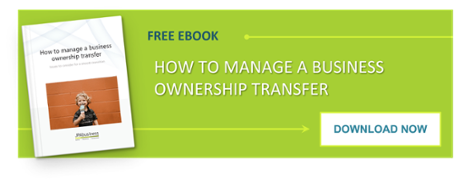
When buying or selling a business, the last thing you want is a handover whereby the business performance is negatively impacted by transfer issues not planned out ahead of time and dealt with appropriately.
There are several important issues a vendor and, by definition, a purchaser need to consider and deal with in the transfer process leading up to settlement.
There is quite a bit of interplay and overlap between the issues but, for the purposes of this blog, I have separated them into seven categories:
- Employees
- Financial
- Customers
- Suppliers
- Stock
- Legal
- Other.
1. Employees
There are a number of business transfer issues related to employee management and two of the most important are:
- Documentation
- Communication.
Documentation
It is important for a new owner to ensure the tenure of employees staying within the business. To do that the relevant documents must be provided to employees and duly executed in the lead-up to completion.
The actual documentation required will depend on what type of sale is occurring:
- If the shares in a company are being sold then the employees will usually transfer under their existing employment agreements, provided there is no requirement for these agreements to be refined as part of the sale terms.
- If the transaction is a going concern asset sale, the vendor is effectively terminating the employment of those people, and the purchaser will need to lodge a fresh letter of employment or employment contract with each employee.
Sometimes we find the employees of a business don’t have any employment instrument in place – no contract and no letter – and have been employed on the basis of a verbal agreement. A purchaser coming in may want to formalise that situation.
In this situation there needs to be correct documentation in place on day one of the new business.
Communication
For employees moving to the new ownership, as well as employees not required by the new owner, there needs to be a clear communication process.
Our vendors are often quite sensitive about when they communicate to their staff about a business sale. Some communicate very early on – even before they have a purchaser in mind. Others leave it until very late in the process when they have binding contracts in place.
There is no right or wrong, but the important thing is that once they decide the time is right to share the news with employees, they do so openly.
The last thing both a vendor and purchaser wants is unsettled and unproductive employees.

2. Financial
There are four main issues to consider in this category:
- Employee entitlements
- Customer accounts
- Work in progress
- Insurance.
Employee entitlements
It is important for both the vendor and purchaser to have a clear understanding of the entitlements associated with each employee who is either leaving the business upon settlement, or going forward with the new ownership.
Entitlements are usually to the vendor’s account, so they’re paid by the vendor up to completion or settlement, or the value is adjusted from the settlement proceeds.
Vendors will need to inform their solicitors of the amount of annual leave, sick leave, long service leave and the like that has been accrued by each employee. There is then a financial process under which those either get paid out or adjusted from the purchase price, or both.
Customer accounts
Another financial issue is the payment of accounts by customers.
The last thing we want to see post-completion is money paid against invoices you have issued as a vendor leading up to completion, going to the purchaser’s account.
Equally the last thing we want to see is the first month of invoices issued by the purchaser being paid to the vendor’s account.
The vendor and purchaser need to work closely, ahead of the completion date, to decide how you’re going to communicate the new arrangements to the business’s customers.
Work in progress
Where a business has jobs and projects that may stretch across the completion date, work in progress will need to be assessed and determined upon completion.
Unless a sale contract determines otherwise, work in progress for a job or project that runs through the sale date needs to be fairly apportioned to the vendor and purchaser commensurate to the amount of work each party has or will have to expend on the project.
A good solicitor and broker will assist you as a vendor develop a work-in-progress schedule to be assessed upon completion, so a fair apportionment can be agreed between the parties.
Insurance
As a vendor you want to ensure you’re well and truly covered by insurances – business, plant and equipment, and building – right through to completion.
It’s equally important to ensure the purchaser is covered right from completion, so no gap can occur which could give cause to later dispute if something adverse did happen during that handover period.
A sound strategy as a vendor is to ensure there is a modest insurance overlap.

3. Customers
We talked earlier about the financial issues related to customers, but there is a separate issue regarding customers and that is ‘relationships’.
A business may have 50 regular and loyal customers and yet 15 of those may represent 60% of the sales on a regular basis.
The vendor needs to think about how they transfer those relationships to the purchaser.
A vendor who shows a willingness to facilitate these meetings and relationships will also place themselves in good stead with the purchaser, which all goes to supporting a successful sale.
Best practice is to plan out a contact program of meetings and greetings ahead of the completion date, even if the actual meetings may not occur until post-completion.

4. Suppliers
Again there are several issues to consider here, with the most important ones being:
- Relationships
- Supplier accounts.
Relationships
If you rely on suppliers for the products you sell you might have relationships with five, 10 or 20 key suppliers.
It’s important to note that a purchaser coming in will need to establish relationships with those suppliers too. They’ll need to do credit applications and sort out terms, and they’ll need those relationships in place from day one, in order to operate.
It’s likely that as the vendor you will be called on to assist in making those connections.
The question is: when should you as a vendor allow a purchaser to contact your suppliers?
Just as a vendor needs to plan out a contact program of meetings and greetings between the purchaser and key customers, so there needs to be a similar contact program arranged with key suppliers. Again, the meetings may take place after completion but it is important to start the process before completion.
Of course, vendors may experience pressure from the purchaser to introduce them to the top five or 10 suppliers and customers before completion. I’ve had circumstances where that has occurred and in some instances it’s a condition of sale.
This is particularly important where there are formal supply or distribution agreements in place that may need to be assessed in the due diligence process or assigned/transferred as part of the sale process. If that’s the case, then that has be arranged ahead of time.
Ideally vendors need to be careful and ensure they have a strongly binding contract before disclosing the sale process to those key suppliers.
Supplier accounts
As a vendor it is equally important to communicate the news of your sale with your suppliers, once you’re sure of it proceeding.
You will need to advise them of the date of completion and the fact your obligations in terms of orders will end on that date, and the new purchasers’ obligations will start on the next due date.

5. Stock
When it comes to buying and selling businesses, a lot of money can be made or lost based on your inventory management.
(This is a subject we covered in detail in our ebook: Managing cash flow and working capital.)
Often businesses are sold subject to a stocktake in the lead-up to or upon completion. Usually stocktakes are held within 24 or 48 hours of completion date.
A stocktake can be quite a significant exercise and there is a lot of value involved. Vendors need to be very planned about how the process will work and they need to include the purchaser in the planning so everyone is clear ahead of time on how it will happen.
A good business broker will offer you as a vendor assistance in planning and running the stocktake to ensure it is appropriately conducted for you, and also to provide the purchaser with confidence it has been robustly undertaken.

6. Legal
There are many legal issues to consider in a business transaction process and, as we have often said in our eBooks and blogs, engaging a solicitor with experience in business sales is critical.
While your solicitor will be best placed to help you prepare for the legal aspects of a business transfer, one area I would like to highlight here is plant and equipment (P&E).
Legal issues related to plant and equipment include:
- Loans and leases on P&E
- Personal Property Securities Register (PPSR)
- Registrations and roadworthiness certificates.
Loans and leases on P&E
When purchasing plant and equipment as part of a business sale, it is normal for the purchaser to require all P&E be ‘free of charge’ i.e. that there are no outstanding leases or loans attached to those assets.
That means you as a vendor need to pay out and remove any charges ahead of a completed sale.
PPSR
You will also need to ensure those leases or loans have not been registered with the Personal Property Securities Register (PPSR) by the lease or loan company or, if they have, that the register is removed once the charge is paid out.
The purchaser will want to know that all registers, claims and encumbrances are removed prior to or at completion.
Registrations and roadworthiness certificates
While P&E may be free of a charge (owned outright) it will still often have registrations and insurances associated with it, and these also need to transferred.
Specialised P&E may have industry certifications or specifications which will need to be reviewed and verified upon transfer at completion.
A good solicitor acting for you as part of the sale process, along with your broker, will help you arrange for registrations to be transferred, but sometimes this process can take quite a while.
Don't leave it to the last minute!
Know what you have to transfer and work through it with the various groups involved, including the leasing firms, banks, registration body and purchaser.
I have seen business sale settlements held up for weeks by these issues.
Transferring a premises lease
Another issue likely to fall in the ‘Legal’ category is the transfer of a premises lease.
If you as the vendor have a landlord and your business premises lease is transferring or being assigned to the purchaser, you will need to allow some time for this process.
Typically landlords have a solicitor or legal advisor operating for them and it will take time for them to transfer and assign your premises lease to another party.
The lease has to transfer at the same time as the business transfers upon settlement, so you need to be well planned.
7. Other
This is a bit of a catch-all area that may include things like logos and marketing material, logins and systems access, licensing for software used in the business, pre-paid advertising, and other pre-paid expenses.
Here are a couple of examples:
Example 1 – You have paid $10,000 for annual Sensis Yellow Pages advertising. You paid it last month and this month you are transferring the business to a new owner. Therefore you have only owned the business for one month out of that 12-month marketing period.
Providing you have covered this issue in the sale contract, you will want to ensure the liability for the remaining 11 months is passed to the purchaser via an adjustment to the purchase price.
The purchaser will require legitimate documentation to show that you’ve actually paid upfront.
If you are paying Sensis by instalments, you need to ensure the account is transferred to the incoming purchaser so you don’t wear those expenses, providing that is also covered in the contract.
Example 2 – You are in your first month of running the business and wish to send out a direct mail communication to all past customers updating them on changes in the business and seeking their feedback.
By ensuring you have ready access to logos and marketing material artwork, you can easily action such a process without delay.
If you need support or advice regarding any aspect of buying or selling a business, contact the team at JPAbusiness on 02 6360 0360 or 02 9893 1803 for a confidential, initial discussion.

